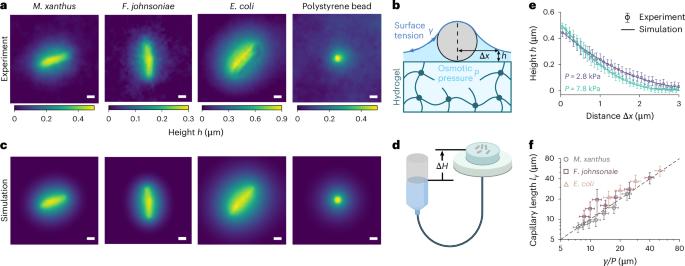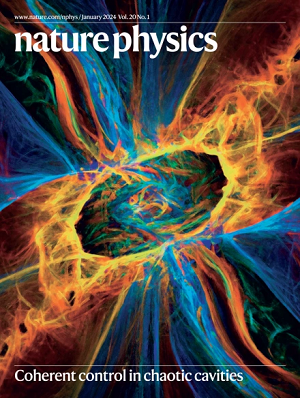Capillary interactions drive the self-organization of bacterial colonies
IF 18.4
1区 物理与天体物理
Q1 PHYSICS, MULTIDISCIPLINARY
引用次数: 0
Abstract
Many bacteria inhabit thin water layers on solid surfaces. These thin films occur both naturally—in soils, on hosts and on textiles—and in the laboratory on agar hydrogels. In these environments, cells experience capillary forces, but it is unclear how these forces shape bacterial collective behaviour. Here we show that the water menisci formed around bacteria lead to capillary attraction between cells while still allowing them to slide past one another. We develop an experimental apparatus that allows us to control bacterial collective behaviour by varying the strength and range of capillary forces. Combining three-dimensional imaging and cell tracking with agent-based modelling, we demonstrate that capillary attraction organizes rod-shaped bacteria into densely packed nematic groups and influences their collective dynamics and morphologies. Our results suggest that capillary forces may be a ubiquitous physical ingredient in shaping microbial communities in partially hydrated environments. Bacteria tend to live in thin layers of water on surfaces. Now the capillary forces in these layers are shown to help organize the bacteria into dense packs.


毛细管相互作用驱动细菌菌落的自组织
许多细菌栖息在固体表面的薄水层上。这些薄膜既存在于土壤、寄主和织物上,也存在于实验室中的琼脂水凝胶上。在这些环境中,细胞经历毛细力,但尚不清楚这些力如何塑造细菌的集体行为。在这里,我们展示了在细菌周围形成的水半月板导致细胞之间的毛细血管吸引,同时仍然允许它们彼此滑动。我们开发了一种实验装置,使我们能够通过改变毛细管力的强度和范围来控制细菌的集体行为。将三维成像和细胞跟踪与基于代理的建模相结合,我们证明了毛细管吸引力将杆状细菌组织成密集排列的向列群,并影响它们的集体动力学和形态。我们的研究结果表明,毛细力可能是在部分水合环境中形成微生物群落的普遍物理成分。
本文章由计算机程序翻译,如有差异,请以英文原文为准。
求助全文
约1分钟内获得全文
求助全文
来源期刊

Nature Physics
物理-物理:综合
CiteScore
30.40
自引率
2.00%
发文量
349
审稿时长
4-8 weeks
期刊介绍:
Nature Physics is dedicated to publishing top-tier original research in physics with a fair and rigorous review process. It provides high visibility and access to a broad readership, maintaining high standards in copy editing and production, ensuring rapid publication, and maintaining independence from academic societies and other vested interests.
The journal presents two main research paper formats: Letters and Articles. Alongside primary research, Nature Physics serves as a central source for valuable information within the physics community through Review Articles, News & Views, Research Highlights covering crucial developments across the physics literature, Commentaries, Book Reviews, and Correspondence.
 求助内容:
求助内容: 应助结果提醒方式:
应助结果提醒方式:


